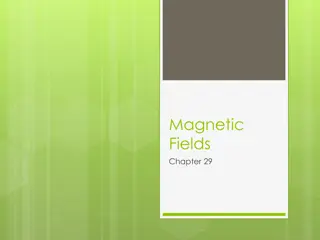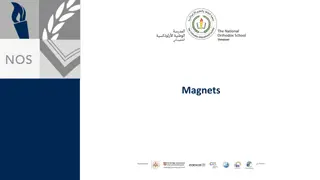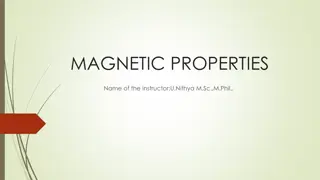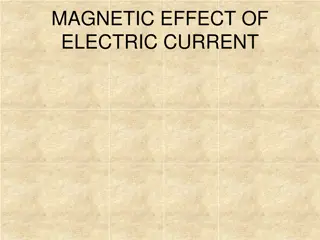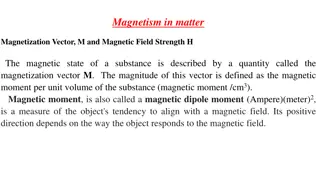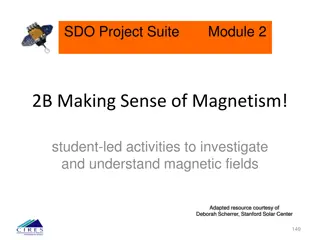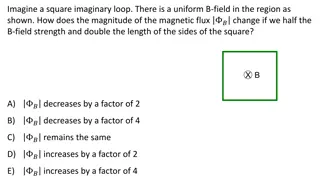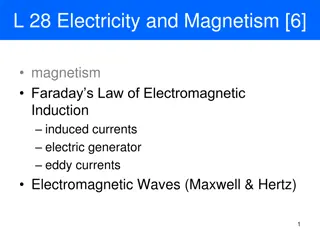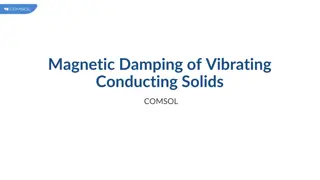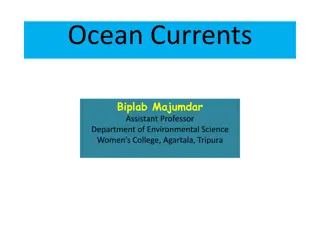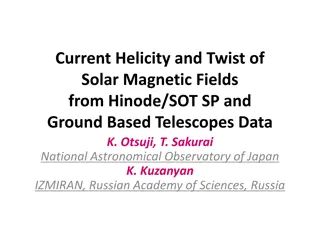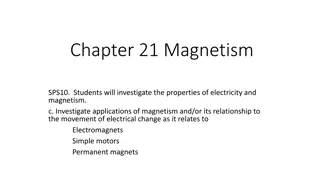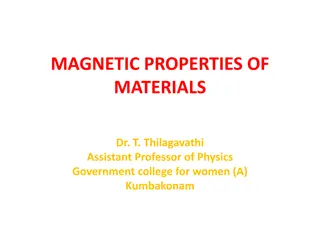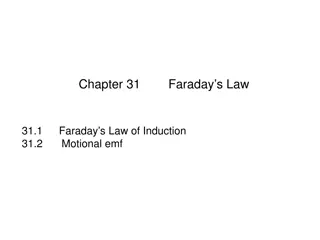Understand Magnetic Fields and Currents in Solids
Explore the concepts of magnetic fields and currents in solids, including the calculation of magnetic dipole moments, the presence of bound currents in cylinders with uniform magnetization, the distribution of bound currents on different surfaces, and the behavior of magnetic fields in solid cylinders with uniform magnetization. Dive into the complexities of surface currents in spheres with uniform magnetization and the direction of bound volume current in a long aluminum rod carrying a distributed current.
Download Presentation

Please find below an Image/Link to download the presentation.
The content on the website is provided AS IS for your information and personal use only. It may not be sold, licensed, or shared on other websites without obtaining consent from the author. Download presentation by click this link. If you encounter any issues during the download, it is possible that the publisher has removed the file from their server.
E N D
Presentation Transcript
6.4 A solid cylinder has uniform magnetization M throughout the volume in the x direction as shown. What's the magnitude of the total magnetic dipole moment of the cylinder? ) R2 L M B) 2 R L M C) 2 R M D) R 2M E) Something else/ it s complicated!
6.3 A solid cylinder has uniform magnetization M throughout the volume in the z direction as shown. Where do bound currents show up? ) Everywhere: throughout the volume and on all surfaces B) Volume only, not surface C) Top/bottom surface only D) Side (rounded) surface only E) All surfaces, but not volume
6.5 A solid cylinder has uniform magnetization M throughout the volume in the x direction as shown. Where do bound currents show up? A) Top/bottom surface only B) Side (rounded) surface only C) Everywhere D) Top/bottom, and parts of (but not all of) side surface (but not in the volume) E) Something different/other combination!
To discuss: A solid cylinder has uniform magnetization M throughout the volume in the z direction as shown. What will the B field look like? (Consider if the cylinder is tall and thin, or short and fat, separately)
6.21 A solid cylinder has uniform magnetization M throughout the volume in the direction as shown. In which direction does the bound surface current flow on the (curved) sides? A. There is no bound surface current. B. The current flows in the direction. C. The current flows in the s direction. D. The current flows in the z direction. E. The direction is more complicated than the answers B, C, or D.
6.6 A sphere has uniform magnetization M in the z direction. Which formula is correct for this surface current? M sinq q A) B) C) D) E) None of these! M sinq j M cosq q M Mcosq j
A very long aluminum (paramagnetic!) rod carries a uniformly distributed current I along the +z direction. What is the direction of the bound volume current? 6.9 A) JB points parallel to I B) JB points anti-parallel to I C) It s zero! D) Other/not sure
6.8 A very long aluminum (paramagnetic!) rod carries a uniformly distributed current I along the +z direction. We know B will be CCW as viewed from above. (Right?) What about H and M inside the cylinder? A) Both are CCW B) Both are CW C) H is CCW, but M is CW D) H is CW, M is CCW E) ???
A very long aluminum (paramagnetic!) rod carries a uniformly distributed current I along the +z direction. What is the direction of the bound volume current? A) JB points parallel to I B) JB points anti-parallel to I C) It s zero! D)Other/not sure
A very long aluminum (paramagnetic!) rod carries a uniformly distributed current I along the +z direction. What is the direction of the bound surface current? 6.9 b A) KB points parallel to I B) KB points anti-parallel to I C) Other/not sure
Summary: A very long aluminum (paramagnetic!) rod carries a uniformly distributed current I along the +z direction. JBpoints parallel to I KB points anti-parallel to I Total bound current vanishes, conservation of charge!
6.8 What if that long rod (the wire) was made of copper (diamagnetic!) instead. Of B, M, H, and J_bound, which ones flip sign ? A) All 4 flip B) 3 of the 4 flip C) 2 of the 4 flip D) 1 of them flips E) None of them flips I The dia case The para case
6.8 What if that long rod (the wire) was made of copper (diamagnetic!) instead. Of B, M, H, and J_bound, which ones flip sign ? B M H A) All 4 flip B) 3 of the 4 flip C) 2 of the 4 flip D) 1 of them flips E) None of them flips I The dia case The para case






